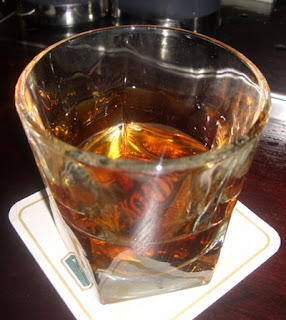1/2 Bourbon (2 oz Old Weller Antique)
1/4 Passion Fruit Juice (1 oz)
1/8 Blue Curaçao (1/2 oz Senior Curaçao + 2 drop blue food coloring)
1/8 Dry Vermouth (1/2 oz Noilly Prat)
2 dash Strawberry Syrup (1/4 oz Strawberry Shrub) (*)
2 dash Angostura Bitters
Shake with ice and strain into a cocktail glass. I opted to strain into a rocks glass filled with crushed ice and garnished with an orange wheel (in retrospect, garnishing with mint would probably work better!).
(*) A good substitution would be either a half strawberry muddled in a 1/4 oz of simple syrup (with the inclusion of a fine straining step at the end) or a 1/4 oz crème de fraise.
When I spotted the Bluebeard's Passion last Saturday night in the
Café Royal Cocktail Book, I first thought it was a Tiki drink named after a pirate akin to
Blackbeard's Ghost. However, given the book, 1937 in the UK probably was an unlikely time and place for Tiki; meanwhile, Don the Beachcomber and Trader Vic were only getting their starts in America. Moreover, Bluebeard was not a pirate but a landloving character in a French literary folktale written in the late 17th century by Charles Perrault, the same author who created Cinderella. In the tale, Bluebeard was a rich nobleman with a penchant for killing off his wives, until the eighth one figured it out. Scholars believe that Perrault modeled the Bluebeard character after a 15th century nobelman, Gilles de Rais, who was quite a prolific serial killer.

Despite the drink pre-dating the Tiki movement, the recipe still contains passion fruit juice and blue Curaçao. The fact that the base spirit was Bourbon instead of rum did not ruin the Tiki feel for I have had Bourbon Tiki drinks such as the
Ken-Tiki. Nor was I deterred by the blue curaçao which I lacked, for it is nothing more than regular liqueur with blue food coloring. Unfortunately the natural blue food coloring that I used did not do as good of a job as the chemical blue food dyes we also have, especially after the brown spirit was added. While the recipe did not suggest serving it over crushed ice, rounding out the Tiki feel seemed appropriate.

The Bluebeard's Passion began with a fruity Bourbon aroma. The whiskey came across in the sip as a malt note that was flavored by the strawberry and Curaçao. Moreover, the Bourbon continued on in the swallow with its barrel-aged heat that was spiced with Angostura and dry vermouth; the passion fruit did not appear until the end where it pleasantly lingered on the aftertaste. As the ice melted, the drink got more interesting as the whiskey became less prominent and the other flavors were allowed to shine; perhaps a less robust Bourbon would work better here, but in the end, the crushed ice did its job to sooth the drink. In retrospect, given the Bourbon and pseudo-Tiki theme, a mint sprig garnish would not be out of place here.




 2 oz Rye Whiskey (Old Overholt)
2 oz Rye Whiskey (Old Overholt)






 The theme for this month's
The theme for this month's 
























 1 oz Berkshire Mountain Distillers Ethereal Gin
1 oz Berkshire Mountain Distillers Ethereal Gin
 1 oz Gin (Cascade Mountain)
1 oz Gin (Cascade Mountain)
 3/4 oz Mezcal Vida (or Blanco Tequila)
3/4 oz Mezcal Vida (or Blanco Tequila)


 The 2017 collection of 855 drink recipes, bartender tributes, and essays on hospitality from CocktailVirgin's Frederic Yarm. Available at
The 2017 collection of 855 drink recipes, bartender tributes, and essays on hospitality from CocktailVirgin's Frederic Yarm. Available at  The 2012 collection of 505 drink recipes, techniques, and Boston bar recommendations from Frederic Yarm. Available at
The 2012 collection of 505 drink recipes, techniques, and Boston bar recommendations from Frederic Yarm. Available at 




